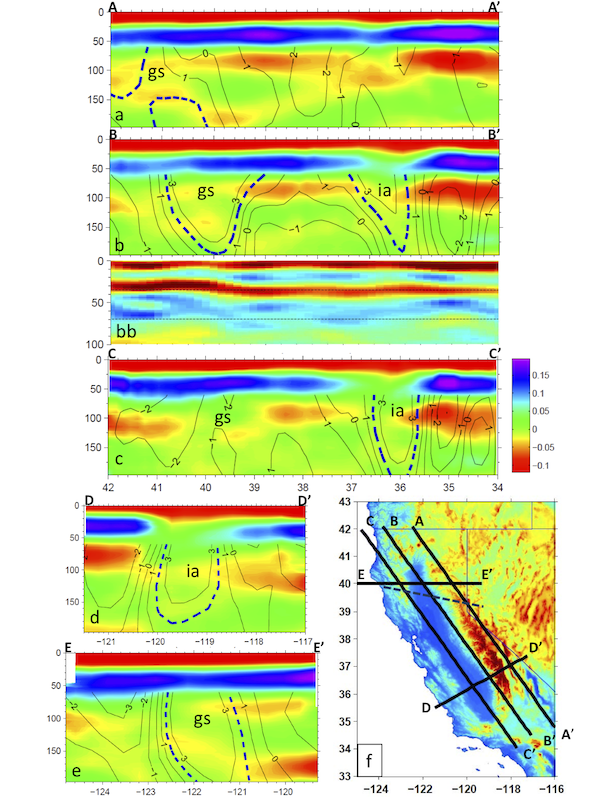2012 IRIS Workshop
Sp Imaging of the Sierra Nevada Range, Isabella Anomaly, and Gorda Plate
Katie Foster: University of Wyoming, Ken Dueker:University of Wyoming, Steve Hansen: University of Wyoming, Brandon Schmandt: CalTech
Sp/Ps image volume sections and P-wave velocity contours (Schmandt and Humphreys, 2010). Gorda slab (gs) and Isabella anomaly (ia) labeled and 2% fast contour outline as dotted blue line. (a) Sp Walker Lane A-A' section. (b) Sp Sierra Nevada Range B-B'. (bb) Ps Sierra Nevada Range B-B' . (c) Sp Great Valley C-C'. (d) Sp Isabella Anomaly D-D'. (e) Gorda slab E-E'. (f) Topography and cross-sections. The blue dotted line marks the southern edge of the Gorda Slab (SEDGE).

Full-resolution graphics file in original format: 0102.pdf
A multi-channel (1200 channels) deconvolution (Hansen and Dueker, 2010) has produced coherent Sp/Ps image volumes from EarthScope/PASSCAL data. Our Sp image finds prominent negative polarity arrivals (NPA) at 80-120 km depth that requires a negative velocity gradient width of <25 km. Comparison of Sp sections with P-wave velocity (Schmandt and Humphreys, 2010) contours finds that the Sp NPA disappears within the high velocity Isabella anomaly (Fig. a-e) and at the top of the Gorda slab (Fig. f). The Sp section parallel to the Sierra Nevada Range (SNR) finds a NPA at 90-110 km depth south of Lake Tahoe except where the Isabella velocity anomaly resides. The same Ps section finds a mostly continuous NPA at about 65 km depth. (Fig. c). We believe the shallower Ps NPA manifests magma fracturing upwards in Ma time-scales while the deeper Sp NPA manifests a wider velocity gradient near the base of the thermal lithosphere. Given the strong evidence for delamination of a sub-batholith restitic root beneath the southern SNR to explain the uplift and change in xenolith composition, we note that our Sp image lacks sufficient lateral resolution to resolve delamination features which may only be the width of the southern SNR (30 km). This lack of lateral resolution is because of reduced seismic sampling of this area with respect to the sampling provided by the SNEP/FAME arrays and hence the use of a coarse model parameterization (100 km bins). Additionally, it is plausible that the delamination of a 30 km by 180 km rectangular swatch of southern SNR restite has left indiscernible seismic anomalies. Finally, we note that the 90-110 km depth Sp NPA beneath the southern SNR does agree with Putirka et al. (2012) conclusion that an isotopically aged and metasomatically enriched lithosphere extends to 75-110 km depth beneath the volcanically sampled SNR. By corollary, interpretation of the Isabella anomaly as a slab fragment (Wang et al., in review) is consistent with our find
For further reading: Hansen, S. and Dueker, K., P- and S-wave Receiver Function Image (2009). Lui, K., et al, Asthenospheric flow and lithospheric evolution (2012). Putirka, K., et al, Cenozoic volcanism in the Sierra Nevada (2012). Schmandt, B. and E. Humphreys, Complex subduction (2010).
Keywords: sp_receiver_function, gorda_plate, ccp_imaging, velocity_anomaly
